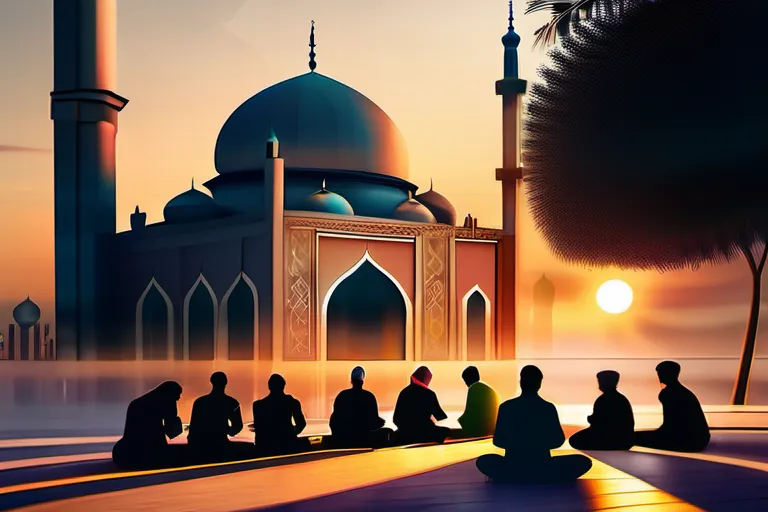Exploring the Misconceptions, Stereotypes, and Historical Context Behind Anti-Islam Feelings
In today’s world, Islam is often portrayed as a religion of extremism, violence, and intolerance. However, this perception is far from the truth. This article delves into the unique aspects that contribute to the most hated religion label for Islam, debunking common misconceptions and providing a nuanced understanding of the faith.
The Historical Context of Islamophobia
The historical context of Islamophobia is like a river, its waters swirling through centuries, carrying whispers and battles that have shaped modern perceptions. How did it all begin? Could it be traced back to the very cradle of Christianity itself – the Crusades?
Imagine knights in armor clashing with Muslim warriors, not just on fields of battle but also in the courtrooms of history. The First Crusade, initiated by Pope Urban II in 1095, was a complex mix of religion and politics. It’s like setting fire to a powder keg; once ignited, the flames spread across time, leaving behind smoldering embers that still spark today.
Fast forward through history, and we see similar echoes of conflict during the colonial era. European powers saw Islam as an obstacle to their expansion, much like a stubborn thorn in the flesh. They often portrayed Muslims as uncivilized or barbaric, justifying their actions under the guise of bringing ‘civilization’ to the East.
Then came modern times with 9/11 and its aftermath. The attacks in New York and Washington D.C. were like a tsunami that reshaped the global landscape. Overnight, Muslims went from being strangers to potential enemies, their religion suddenly seen as a threat to Western values and ways of life.
But let’s not forget the role of media and politics. How often have we heard leaders blame Islam for societal issues, framing it as the villain in an ongoing narrative of fear? It’s like painting a target on a group, making them easy scapegoats for complex problems. Media plays its part too; sensationalism sells, and sometimes that means exaggerating or distorting facts about Islam to attract viewers.
From the Crusades to 9/11, then through colonialism and into the modern age, the roots of anti-Islam sentiment run deep. Each event and era has contributed its share of dirt to this muddy river, making it murky and hard to navigate. But understanding these historical contexts is crucial if we are to truly comprehend why Islam might be seen as the most hated religion today.
Misconceptions About Islam
When we discuss what makes Islam the most hated religion, one of the first misconceptions that often comes to mind is the idea that it inherently promotes violence and intolerance. Is this really true? Let’s delve into some of these claims.
Is Islam synonymous with violent extremism as many seem to believe? The reality is far more complex. While there have been instances of violence in the name of Islam, the religion itself emphasizes peace and mercy. Many verses from the Quran advocate for compassion and justice, asking Muslims to treat others kindly and to seek peace wherever possible.
Imagine a garden where every flower represents a different faith or belief system. Would it be fair to say that because one plant is wilting, all plants in the garden are dying? Similarly, just because some individuals misuse their beliefs doesn’t mean an entire religion is responsible for such actions. It’s crucial to separate acts of violence from the core teachings and values of Islam.
Another common misconception is that Muslims are intolerant towards other religions. The Prophet Muhammad himself encouraged dialogue and respect between different faiths, promoting a message of coexistence and mutual understanding. In fact, many Islamic scholars have long advocated for religious tolerance and peace.
But why do these misconceptions persist? It could be that media representation plays a significant role in shaping public perception. Often, negative stories about Islam dominate the news cycle, creating an echo chamber of fear and misunderstanding. This bias can reinforce stereotypes and fuel hate towards Muslims, making them seem more foreign and dangerous than they truly are.
It’s important to remember that every person has a unique story, shaped by their personal beliefs, experiences, and environment. Just as no single person should be judged based on the actions of others in their community, neither should an entire religion be judged based on a few isolated incidents.
By educating ourselves about Islam—its teachings, its history, and its people—we can begin to break down these barriers and build bridges of understanding. After all, isn’t it easier to love someone when we truly understand them?
Cultural Differences and Stereotypes
When we delve into what makes Islam the most hated religion, one key aspect often emerges: cultural differences and stereotypes. Can you imagine walking down the streets of different parts of the world and noticing how people view Muslims? The Western perspective on Islam is starkly different from that in Islamic societies, creating a complex landscape of misunderstandings.
Take, for instance, the perception of women’s roles. In many Western societies, there is a tendency to view Islamic dress codes as oppressive, when in reality, these practices are deeply rooted in cultural and religious beliefs. Why do we so often judge an entire culture based on a few visible customs? Could it be that our understanding is skewed by stereotypes rather than an open heart?
Another stereotype is the idea that all Muslims are inherently terrorists or extremists. This oversimplification ignores the vast diversity within Islam, just as it does within any other religion. How many times have we heard stories of Muslim individuals who have bravely stood against terrorism and violence? Yet these narratives often get overshadowed by sensational headlines and movies.
Understanding cultural differences is crucial. For instance, in Islamic societies, concepts like hospitality (salaam) are fundamental values that are deeply ingrained in daily life. How can we reconcile this with the image of Muslims as violent or uncivilized?
The challenge lies not only in recognizing these differences but also in fostering mutual respect and understanding. Can you imagine a world where people from different cultural backgrounds sit down and discuss their traditions and beliefs without judgment? It’s possible, but it requires empathy and an openness to learn.
In conclusion, the hate towards Islam is often rooted in these deep-seated stereotypes and misunderstandings. By examining cultural differences, we can begin to bridge gaps and build a more inclusive society where every religion is respected for its unique contributions. After all, isn’t understanding the heart of what makes each culture beautiful?
Media Portrayals of Islam
Media portrayals of Islam often paint a picture that can be both misleading and damaging. Have you ever wondered why certain images stick in our minds when we hear the word ‘Islam’? Are these depictions always accurate, or do they serve to perpetuate harmful stereotypes?
Consider the news cycle: every time there’s a terrorist attack somewhere in the world, headlines often link it back to Islam. This constant association can make people forget that not all Muslims are terrorists. It’s like labeling an entire neighborhood based on one criminal case – unfair and unrealistic.
On the flip side, when positive stories about Islamic cultures or communities emerge, they tend to be overshadowed by these negative narratives. For instance, how often do we hear about Muslim scientists, artists, or entrepreneurs making significant contributions to society? These are important stories that need to be highlighted as much as the negatives.
The media’s role in shaping perceptions is crucial. It can either reinforce harmful stereotypes or challenge them. When journalists and news outlets fail to provide balanced coverage, they contribute to a climate of fear and misunderstanding. Is it not true that we should demand more nuanced reporting on Islam? Shouldn’t we question why certain stories about the religion dominate our media?
It’s important to recognize that media bias isn’t just about what is left out but also how information is presented. The way a story is framed can significantly influence public opinion. For example, depicting every Muslim as a potential threat or portraying Islam as an oppressive force can create a fear-based narrative that alienates entire communities.
How can we ensure that media portrayals of Islam are more balanced and fair? Perhaps by supporting journalists who strive for accuracy and inclusivity. By demanding better from our news sources, we can help shift the discourse away from harmful stereotypes towards a more nuanced understanding of what it means to be Muslim in today’s world.
The Impact of Islamophobia Today
What makes Islam the most hated religion? Today, this question lingers like a shadow over global communities, casting doubts and fears into everyday life. When we delve into the consequences of Islamophobia, it’s like unraveling a complex puzzle—each piece revealing layers of discrimination, violence, and social exclusion.
Take a moment to ponder: Does the media’s portrayal play a significant role in shaping public opinion? Or are there deeper historical roots that have led to this pervasive hatred? One cannot help but wonder if it’s merely a case of misunderstanding or something far more complex. The impact of Islamophobia today is profound, affecting communities worldwide.
Consider the daily experiences of Muslims who face discrimination and prejudice in their workplaces, schools, and neighborhoods. How does this make them feel? Isolation, fear, and uncertainty are common emotions, painting a stark picture of social exclusion. The ripple effect is even more alarming when we see instances of violence, from hate crimes to acts of terror falsely attributed to Islam.
These incidents serve as a wake-up call, reminding us that the impact of Islamophobia extends beyond individual lives and touches the very fabric of society. It undermines social cohesion and mutual respect. Imagine a world where everyone could freely practice their religion without fear or discrimination—wouldn’t that be a more harmonious place to live?
As we explore these issues, it’s crucial to recognize that addressing Islamophobia requires a multi-faceted approach. From media literacy to policy changes and community engagement, each step is vital in breaking down barriers of misunderstanding and fostering an inclusive society.
Promoting Understanding and Tolerance
How can we break down barriers between communities and promote understanding and tolerance towards Islam?
- Start with education. Many misconceptions about Islam stem from a lack of knowledge. Encourage your local schools to include accurate information about the religion in their curricula. Knowledge is a powerful tool against ignorance.
- Organize interfaith dialogue events. These can be informal get-togethers or formal discussions, but the goal is to create an open space where people from different backgrounds can share their experiences and learn from each other. Imagine if every community center had a designated spot for such dialogues!
- Engage in media literacy. Encourage critical thinking about how Islam is portrayed in the media. Share articles, books, and documentaries that present an accurate picture of Islamic beliefs and practices. What would it take for you to start recommending such resources to friends and family?
The key is to approach these steps with a mind open to change. We all have biases, and challenging them can be uncomfortable but necessary. Let’s imagine a world where understanding and tolerance are not just ideals but everyday realities. What small step can you take today to contribute to that vision?
In promoting understanding and tolerance of Islam, we must also recognize the role of empathy. Empathy helps us see beyond stereotypes and understand the humanity in every individual, regardless of their religious beliefs. Can you think of a time when empathy changed your perspective on someone or something? If so, how can that experience guide your efforts to promote interfaith dialogue?
Conclusion
 By examining the historical context, cultural differences, and media portrayals, we can gain a deeper appreciation for the complexities of Islam and challenge the negative stereotypes that persist today. It is essential to promote understanding and tolerance in our increasingly interconnected world.
By examining the historical context, cultural differences, and media portrayals, we can gain a deeper appreciation for the complexities of Islam and challenge the negative stereotypes that persist today. It is essential to promote understanding and tolerance in our increasingly interconnected world.











